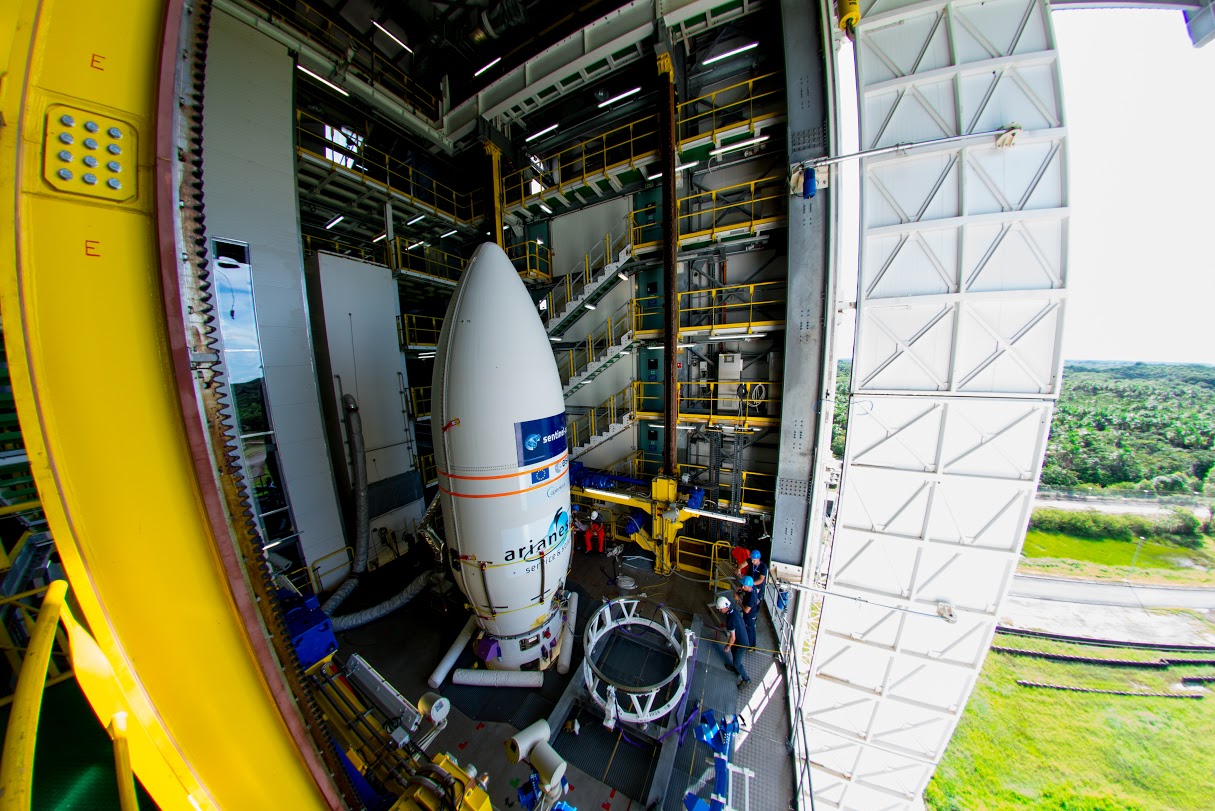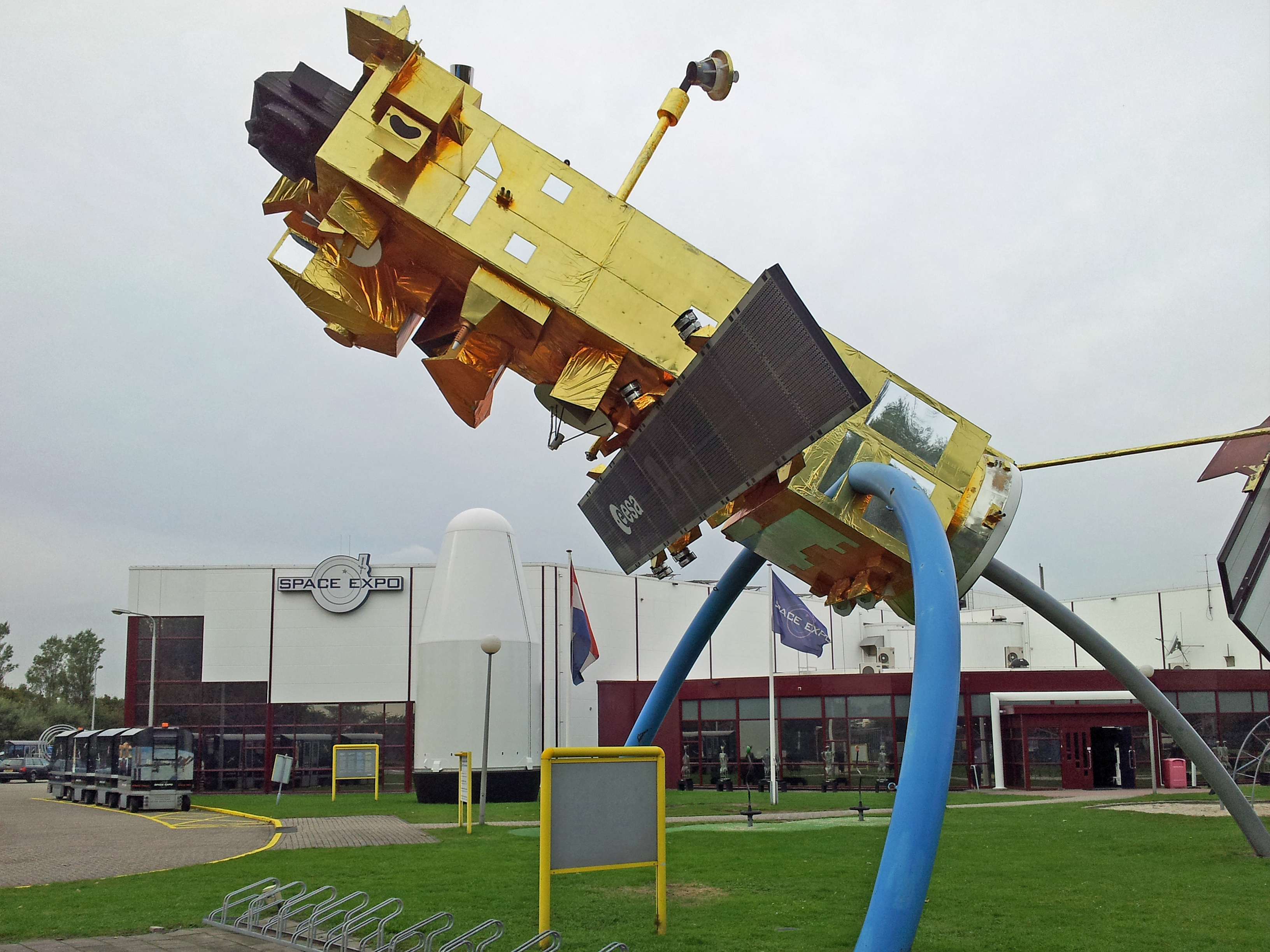|
Sentinel-2B
Sentinel-2B is a European optical imaging satellite that was launched on 7 March 2017. It is the second Sentinel-2 satellite launched as part of the European Space Agency's Copernicus Programme, and with its orbit phased 180° against its sister satellite, Sentinel-2A. The satellite carries a wide swath high-resolution multispectral imager with 13 spectral bands. It provides information for agriculture and forestry, among other services, allowing for prediction of crop yields. Mission history A €105 million contract for the construction of the spacecraft was signed in March 2010 by ESA's Director of Earth Observation Programmes and the CEO of Astrium, Astrium Satellites. It was completed in June 2016, and the satellite was transported to the European Space Research and Technology Centre (ESTEC) for the test campaign. Launch The spacecraft arrived at the Guiana Space Centre, Centre Spatial Guyanais on 6 January 2017 for pre-launch operations. Launch took place at the nomi ... [...More Info...] [...Related Items...] OR: [Wikipedia] [Google] [Baidu] |
Sentinel-2C
Sentinel-2 is an Earth observation mission from the Copernicus Programme that acquires optical imagery at high spatial resolution (10 m to 60 m) over land and coastal waters. The mission's Sentinel-2A and Sentinel-2B satellites were joined in orbit in 2024 by a third, Sentinel-2C, and in the future by Sentinel-2D, eventually replacing the A and B satellites, respectively. The mission supports services and applications such as agricultural monitoring, emergencies management, land cover classification, and water quality. Sentinel-2 has been developed and is being operated by the European Space Agency. The satellites were manufactured by a consortium led by Airbus Defence and Space in Friedrichshafen, Germany. Overview The Sentinel-2 mission includes: * Multispectral image, Multi-spectral data with 13 bands in the Visible spectrum, visible, Infrared#Regions within the infrared, near infrared, and Infrared#Regions within the infrared, short wave infrared part of the Electromagnetic ... [...More Info...] [...Related Items...] OR: [Wikipedia] [Google] [Baidu] |
Sentinel-2A
Sentinel-2A is a European optical imaging satellite launched in 2015. It is the first Sentinel-2 satellite launched as part of the European Space Agency's Copernicus Programme. The satellite carries a wide swath high-resolution multispectral imager with 13 spectral bands. Its observations support services such as forest monitoring, land cover change-detection, natural disaster management and water quality monitoring. On 7 March 2017 the Sentinel-2A was joined in orbit by its sister satellite, Sentinel-2B. Mission history Launch Sentinel 2A was launched by the Vega (rocket), Vega Vega flight VV05, VV05 rocket on 23 June 2015 at 01:52 UTC. The satellite separated from the upper stage 54 min 43 s after liftoff. Orbital operation The satellite captured its first image 100 hours after launch, covering a wide swath from Sweden through Central Europe to Algeria. Commissioning occurred in October 2015. Between 20 and 23 January 2017 the spacecraft suffered a mission planning ano ... [...More Info...] [...Related Items...] OR: [Wikipedia] [Google] [Baidu] |
Vega (rocket)
Vega (, , ) was a European expendable small-lift launch vehicle developed by Avio and operated by Arianespace for the European Space Agency (ESA) and the Italian Space Agency (ASI). Designed to carry payloads between into low Earth and polar orbits, Vega served primarily scientific and Earth observation missions. Development of Vega began in 1998, with its maiden flight launched from the Guiana Space Centre on 13February 2012. Over the next decade, it became the eighth most launched small-lift launch vehicle history, though it struggled to compete in the commercial launch market. After initial success, two in-flight failures and rising competition from SpaceX's rideshare programs, which offered lower prices, relegated Vega to primarily serving European government agencies willing to pay more to support independent space access. The rocket took its name from Vega, the brightest star in the constellation Lyra. It featured a single-body design without strap-on boosters, con ... [...More Info...] [...Related Items...] OR: [Wikipedia] [Google] [Baidu] |
ELA-1
ELV () is a launch complex at the Guiana Space Centre in French Guiana supporting launches of the Vega and Vega C rockets. It was first built in November 1971 and was previously used to support launches of the Europa, Ariane 1 and Ariane 3 rockets. History Europa (BEC) ELA-1, at the time designated BEC () was constructed as an equatorial launch site for the Europa-II rocket which was being built as part of the ELDO programme. The first launch occurred on 5 November 1971. This was the only flight of the Europa-II, which ended in failure due to a guidance problem. The launch site was mothballed, and later demolished. Ariane (ELA) When the Ariane 1 programme was started, to replace the failed ELDO programme, a new launch site was built on the site of the former BEC, re-designated as ELA (). The first Ariane 1 launch occurred on 24 December 1979. ELA was also used by Ariane 2 and Ariane 3 rockets, which first flew on 31 May 1986 and 4 August 1984 respectively. ELA wa ... [...More Info...] [...Related Items...] OR: [Wikipedia] [Google] [Baidu] |
Copernicus Programme
Copernicus is the Earth observation component of the European Union Space Programme, managed by the European Commission and implemented in partnership with the Member state of the European Union, EU member states, the European Space Agency (ESA), the European Organisation for the Exploitation of Meteorological Satellites (EUMETSAT), the European Centre for Medium-Range Weather Forecasts (ECMWF), the Joint Research Centre (JRC), the European Environment Agency (EEA), the European Maritime Safety Agency (EMSA), Frontex, European Union Satellite Centre, SatCen and Mercator Océan. The programme aims at achieving a global, continuous, autonomous, high quality, wide range Earth observation capacity. Providing accurate, timely and easily accessible information to, among other things, improve the management of the environment, understand and Climate change mitigation, mitigate the effects of climate change, and ensure civil security. Since 2021, Copernicus is a component of the Europ ... [...More Info...] [...Related Items...] OR: [Wikipedia] [Google] [Baidu] |
Earth Observation
Earth observation (EO) is the gathering of information about the physical, chemical, and biosphere, biological systems of the planet Earth. It can be performed via remote sensing, remote-sensing technologies (Earth observation satellites) or through direct-contact sensors in ground-based or airborne platforms (such as weather stations and weather balloons, for example). According to the Group on Earth Observations (GEO), the concept encompasses both "space-based or remotely-sensed data, as well as ground-based or In situ#Earth and atmospheric sciences, in situ data". Earth observation is used to monitor and assess the status of and changes in natural environment, natural and built environments. Terminology In Europe, ''Earth observation'' has often been used to refer to satellite-based remote sensing, but the term is also used to refer to any form of observations of the Earth system, including in situ and airborne observations, for example. The GEO, which has over 100 member coun ... [...More Info...] [...Related Items...] OR: [Wikipedia] [Google] [Baidu] |
Spacecraft Launched By Vega Rockets
A spacecraft is a vehicle that is designed to fly and operate in outer space. Spacecraft are used for a variety of purposes, including communications, Earth observation, meteorology, navigation, space colonization, planetary exploration, and transportation of humans and cargo. All spacecraft except single-stage-to-orbit vehicles cannot get into space on their own, and require a launch vehicle (carrier rocket). On a sub-orbital spaceflight, a space vehicle enters space and then returns to the surface without having gained sufficient energy or velocity to make a full Earth orbit. For orbital spaceflights, spacecraft enter closed orbits around the Earth or around other celestial bodies. Spacecraft used for human spaceflight carry people on board as crew or passengers from start or on orbit (space stations) only, whereas those used for robotic space missions operate either autonomously or telerobotically. Robotic spacecraft used to support scientific research are space prob ... [...More Info...] [...Related Items...] OR: [Wikipedia] [Google] [Baidu] |
Earth Observation Satellites Of The European Space Agency
Earth is the third planet from the Sun and the only astronomical object known to Planetary habitability, harbor life. This is enabled by Earth being an ocean world, the only one in the Solar System sustaining liquid surface water. Almost all of Earth's water is contained in its global ocean, covering Water distribution on Earth, 70.8% of Earth's crust. The remaining 29.2% of Earth's crust is land, most of which is located in the form of continental landmasses within Earth's land hemisphere. Most of Earth's land is at least somewhat humid and covered by vegetation, while large Ice sheet, sheets of ice at Polar regions of Earth, Earth's polar polar desert, deserts retain more water than Earth's groundwater, lakes, rivers, and Water vapor#In Earth's atmosphere, atmospheric water combined. Earth's crust consists of slowly moving tectonic plates, which interact to produce mountain ranges, volcanoes, and earthquakes. Earth's outer core, Earth has a liquid outer core that generates a ... [...More Info...] [...Related Items...] OR: [Wikipedia] [Google] [Baidu] |
European Space Research And Technology Centre
The European Space Research and Technology Centre (ESTEC) is the European Space Agency's main technology development and test centre for spacecraft and space technology. It is situated in Noordwijk, South Holland, in the western Netherlands, although several kilometers off the village but immediately linked to the most Northern district of the nearby town Katwijk. At ESTEC, about 2500 engineers, technicians and scientists work hands-on with mission design, spacecraft and space technology. ESTEC provides extensive testing facilities to verify the proper operation of spacecraft, such as the Large Space Simulator (LSS), acoustic and electromagnetic testing bays, multi-axis vibration tables and the ESA Propulsion Laboratory (EPL). Prior to launch, all of the equipment that ESA launches is tested in some degree at ESTEC, other than those tested at national space centers of ESA member countries. The Space Expo is ESTEC's visitors centre. It has a permanent exhibition about space explor ... [...More Info...] [...Related Items...] OR: [Wikipedia] [Google] [Baidu] |
Astrium
Astrium was a European aerospace company and subsidiary of the European Aeronautic Defence and Space Company (EADS), headquartered in Paris. It designed, developed and manufactured civil and military space systems and provided related services from 2006 to 2013. In 2012, Astrium had a turnover of €5.8 billion and 18,000 employees in France, Germany, the United Kingdom, Spain and the Netherlands. Astrium was a member of Institute of Space, its Applications and Technologies. In late 2013 Astrium was merged with Cassidian, the defence division of EADS, as well as Airbus Military to form Airbus Defence and Space. EADS itself was rebranded Airbus Group, with three divisions: Airbus Commercial Aircraft, Airbus Defence and Space, and Airbus Helicopters. Business structure During 2006–2013, the three main areas of activity within Astrium were: * Astrium Satellites for spacecraft and ground segment * EADS Astrium Space Transportation for launchers and orbital infrastructure * ... [...More Info...] [...Related Items...] OR: [Wikipedia] [Google] [Baidu] |
Crop Yield
In agriculture, the yield is a measurement of the amount of a crop grown, or product such as wool, meat or milk produced, per unit area of land. The seed ratio is another way of calculating yields. Innovations, such as the use of fertilizer, the creation of better farming tools, and new methods of farming and improved crop varieties have improved yields. The higher the yield and more intensive use of the farmland, the higher the productivity and profitability of a farm; this increases the well-being of farming families. Surplus crops beyond the needs of subsistence agriculture can be sold or bartered. The more grain or fodder a farmer can produce, the more draft animals such as horses and oxen could be supported and harnessed for labour and production of manure. Increased crop yields also means fewer hands are needed on farm, freeing them for industry and commerce. This, in turn, led to the formation and growth of cities, which then translated into an increased demand for foodst ... [...More Info...] [...Related Items...] OR: [Wikipedia] [Google] [Baidu] |





